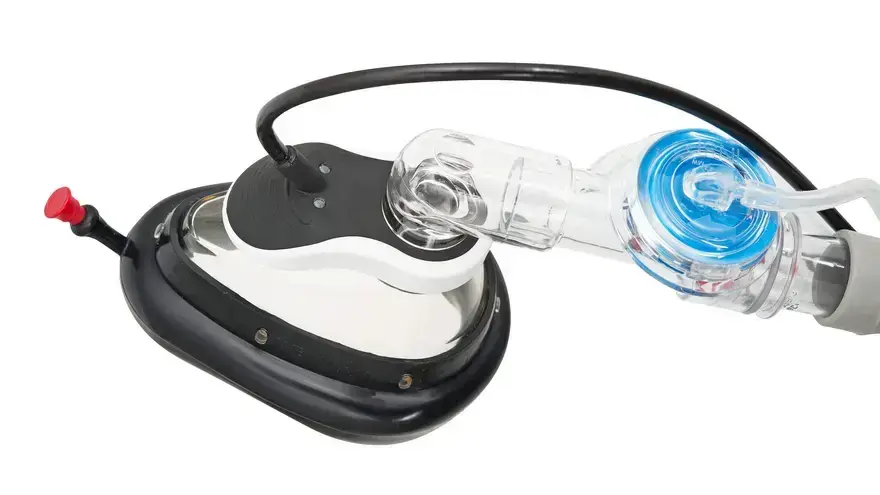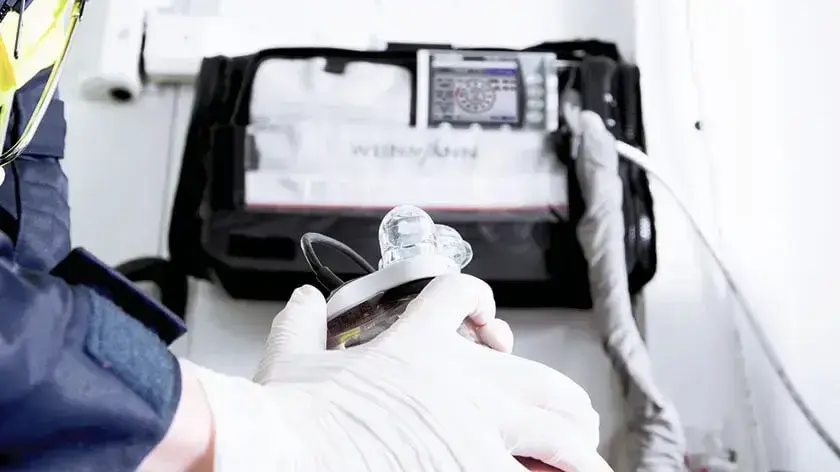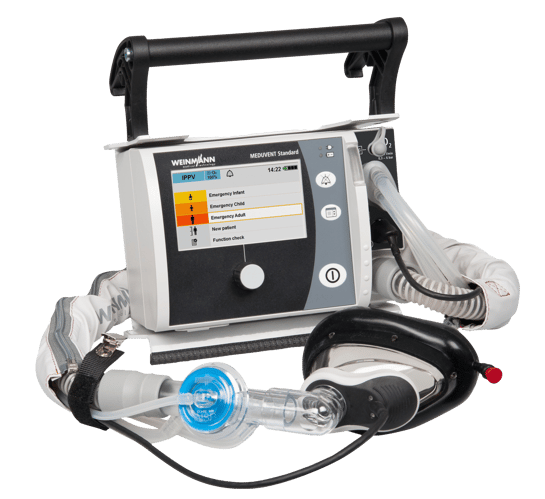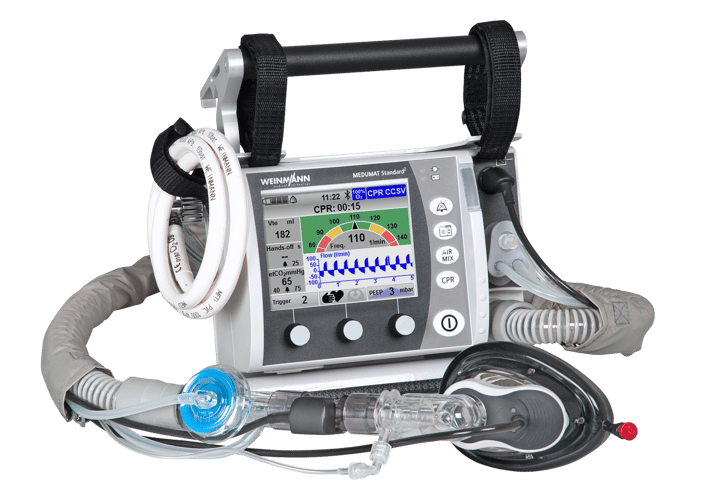
Deliver precise mechanical breaths with MEDUtrigger
Full control - during Cardiopulmonary Resuscitation and Anesthesia Induction (RSI).
The MEDUtrigger, integrated with the Meduvent Standard, offers clinicians precise control during ventilation, especially in critical scenarios such as cardiac arrest and rapid sequence induction (RSI).
The MEDUtrigger modernises manual ventilation, providing clinicians with a reliable and efficient tool to enhance patient care during emergency interventions. The trigger is located right on the mask which is connected to the ventilator via electric cable.
Key Benefits for Clinicians:
- Allows one clinician to maintain a secure mask seal using both hands while delivering breaths via a thumb-activated trigger.
- Compatible with all basic and advanced airway adjuncts.
- Pre-set tidal volume and pressure limits help prevent hypo- or hyperventilation and reduce the risk of gastric insufflation.
- During cardiac arrest deliver two consecutive mechanical breaths in line with resuscitation protocols when the trigger is pressed and held.
- The ventilator continuously monitors inspiratory minute volume, oxygen concentration, and respiratory rate, issuing visual or audible alerts in potentially hazardous situations.
- Works seamlessly with both manual & mechanical chest compressions during cardiac arrest.
- Quick, intuitive operation ensures timely ventilation when seconds count, especially in high-stress scenarios.
- Ideal for use during anaesthesia induction or cardiac arrest, with the flexibility to switch to continuous ventilation as needed.
- Improves ventilation efficacy by minimising air leaks during mask ventilation.



The limitations of BVM manual ventilation
Bag-Valve-Mask (BVM) ventilation in emergencies has limitations. It requires skill to provide consistent ventilation, and fatigue can reduce effectiveness. Risks include gastric inflation, aspiration, and difficulty maintaining a proper seal, especially in patients with facial trauma or obesity. During patient transport and high-stress scenarios delivering steady ventilation is challenging, and BVM use ties up a rescuer’s hands, limiting multitasking. Additionally, the risk of unintentional hyperventilation can negatively impact patient outcomes. For prolonged resuscitation or transport, mechanical ventilation is often preferred for consistent and controlled oxygen delivery.
What is Mechanical Ventilation?
Mechanical ventilation is vital in emergencies, maintaining respiration and oxygen supply when patients can't breathe independently. It offers key advantages over manual ventilation (BVM) and can save lives.
Mechanical ventilation is a method where a ventilator is used to regulate and support alveolar ventilation. This guarantees a constant volume and a constant respiratory rate. Positive airway pressure ensures that the respiratory gas is transported into the lungs.
WEINMANN provides a range of emergency and transport ventilators to support critical care when it matters most.
Ventilators from WEINMANN
WEINMANN ventilators are specially designed for emergency use, making them ideal for both outdoor environments and during patient transport. These ventilators provide flexibility by offering both invasive and non-invasive ventilation options. They are also equipped to support cardiopulmonary resuscitation (CPR) by adhering to CPR guidelines through specialised CPR and CCSV (Chest Compression Synchronised Ventilation) modes.
Integrated monitors allow the ventilation parameters to be monitored and provide visual and acoustic signals to warn of any deviations. This means that both hypoventilation and hyperventilation can be effectively avoided, as precise setting and monitoring functions are available.




When is Mechanical Ventilation beneficial in Emergency Care?
Mechanical ventilation is essential when patients cannot maintain adequate ventilation or oxygenation. It's commonly used during anaesthesia, respiratory failure, traumatic injury, cardiac arrest, or to support airway protection during RSI.
Scroll through the various scenarios to learn more.

During CPR
In cases of cardiac arrest, rapid intervention is crucial. Mechanical ventilation maintains oxygen supply and gas exchange in the lungs, aiding resuscitation until the patient can breathe independently.

During Patient Transport
For critically ill patients, maintaining oxygen supply during transport—whether in an ambulance or a mobile intensive care unit—is essential. Mechanical ventilation allows continuous respiratory support enhancing patient care and crew safety without manual intervention.

Non-Invasive Ventilation Support
Mechanical ventilators also offer non-invasive support, like CPAP therapy, which helps manage conditions such as acute pulmonary oedema, improving patient outcomes.
The Emergency Response teams who benefit from mechanical ventilators.
Equipped with a broad range of ventilation modes, the WEINMANN ventilators can be flexibly adapted to a huge variety of medical requirements – whether for use by emergency medical services or military medical corps, during disaster response operations, or in hospitals.
Scroll through the various applications to learn more.

Emergency Medical Services
WEINMANN ventilators are specially designed for emergency medical use, providing quick and dependable ventilation for patients of all ages in critical situations. The CCSV mode of MEDUMAT Standard², for example aids resuscitation care by synchronising ventilation with chest compressions.

Medical Corps
Medical corps require robust and flexible ventilators that can withstand demanding conditions. WEINMANN ventilators are lightweight, compact, and portable, making them ideal for different operational scenarios.
Features like the CBRN filter and night vision modes offer excellent support for tactical medicine.

Disaster Control
In disaster response operations, ventilators with long-lasting batteries are essential. MEDUVENT Standard from WEINMANN, for example, can provide ventilation for up to 7.5 hours with no external power or compressed gas supply. This feature is especially useful in remote or hard-to-reach areas where oxygen might be limited.

Air Rescue
In air rescue, every gram matters. MEDUVENT Standard is one of the lightest devices available, making it perfect for helicopters and airplanes where space and resources are tight.

Hospital Crash Teams
WEINMANN ventilators are compact and lightweight, making them easy to move around hospitals and quickly accessible wherever needed. The CCSV mode of MEDUMAT Standard², for example, improves resuscitation care by synchronising ventilation with chest compressions.

Hospital Emergency Department
In the busy environment of a central emergency room, WEINMANN ventilators, with their audible and visual warning signals and ability to precisely control pressure and volume, are indispensable. They enable vital signs to be monitored reliably, ensuring patient safety, even in high-pressure situations.
